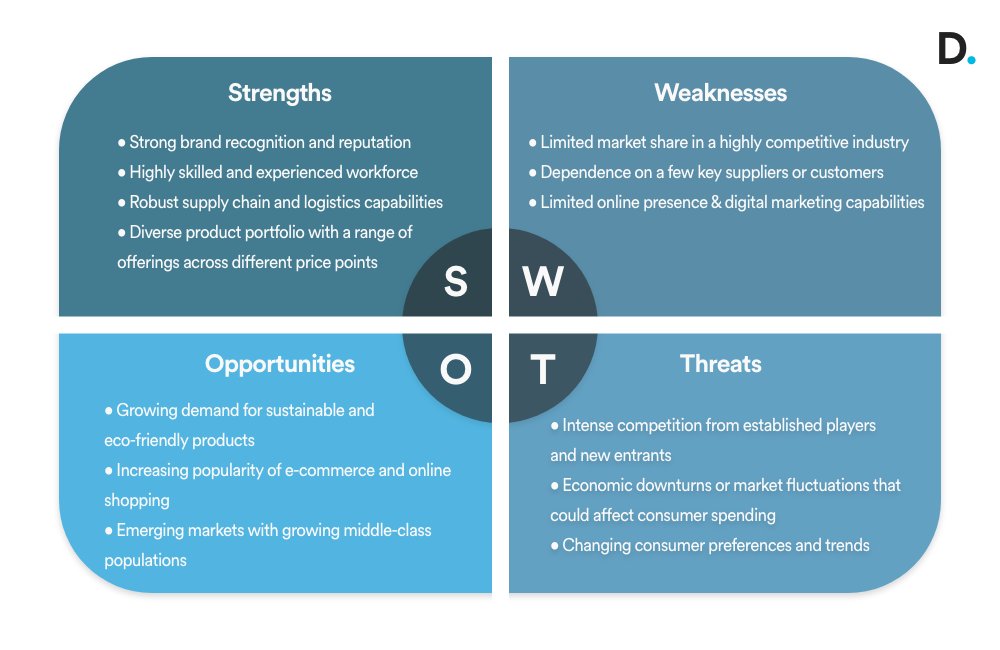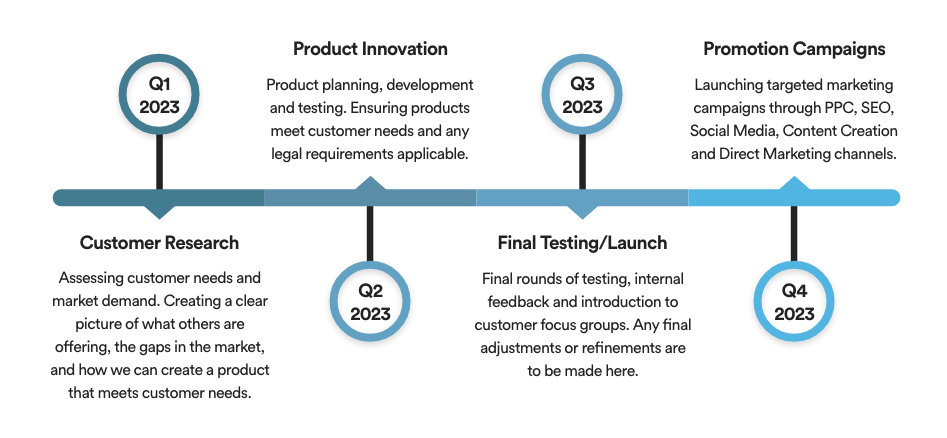Why You Need to Create a Business Growth Roadmap
Table of Contents
Growing your business isn’t a straightforward task.
It takes a lot of planning, action, optimisation, and time to grow your business sustainably.
Without a roadmap that clearly lays out your objectives, how you’re going to achieve them and your deadlines, you’ll have a hard time consistently hitting your growth goals.
In this blog post, we’ve gone in-depth on what a business growth roadmap is, why creating one is essential, and the areas to look at when building your business growth roadmap.
What is a Business Growth Roadmap?
A business growth roadmap is a strategic plan that outlines the steps your business will take to reach your growth goals.
It’s the visual representation of your business’ vision, mission, values, objectives, and specific actions and timelines required to achieve them.
A well-structured growth roadmap should cover all areas of your business, like Marketing, Sales, Operations, Recruitment, and Training. It should help you manage your workload and objectives more efficiently and create a clear action plan and forecast for your business over the next few years.

Why a Business Growth Roadmap is Important
So, I’ve already touched on what a business growth roadmap can provide, but there’s more to it than just setting goals and guiding your business. Here’s a breakdown of why creating and following a growth roadmap is essential.
Clarity on Goals
A business growth roadmap provides a clear and detailed plan of action for your business, outlining the steps and actions you need to take to reach your growth goals.
Once you’ve got a strong business growth roadmap in place, sharing it with the relevant people within your business ensures that every department and team is working towards the same objectives and that they’re all aware of their roles in achieving them.
Prioritisation of Action
A roadmap helps you prioritise the different areas of your business and allocate the right amount of time and resources to help them grow.
For example, if one of your biggest goals for growth is to increase your annual revenue by 30% year on year. Then you can prioritise your Sales and Marketing actions to ensure you’re bringing in enough new business to reach that goal, and put more focus into your Operations and Customer Service to ensure you’re retaining that new business over the long term.
If one of your goals is to grow your workforce, then you’ll need to prioritise Recruitment and Training actions to ensure you bring on enough new staff and provide them with the proper training.
Flexibility of your Plan
Even the best-laid plans sometimes go down the toilet. That’s why you shouldn’t create a ‘fixed’ business growth plan and always leave room for flexibility.
In business, problems regularly pop up out of the blue, just as Coronavirus popped up in 2020 or inflation crept up last year. Issues you might not have planned for can cause havoc with your business and progress towards your growth goals.
Having a flexible business growth plan means you can adapt your strategy when problems arise.
I know saying “Be flexible!” is extremely vague, so here’s what that flexibility in your plan might look like:
- Planning Multiple Outcomes: Rather than relying on a single plan, you could prepare for multiple scenarios that cover different outcomes. For example, if Strategy 1 doesn’t work, rather than standing around scratching your head, you can switch to Strategy 2; and if that doesn’t work, you can try Strategy 3, and so on.
- Regular Reviews & Updates: You could routinely check your strategy’s progress and update it if some aspects aren’t working. This way, you can see what’s working and what’s not and tweak your approach to reach your goals.
- Agile Resource Allocation: Your plan should allow flexibility in allocating people, tech and your budget to different areas of your business growth. This again means that if some areas of your business are underperforming or need more support, you can quickly pivot and allocate resources as needed.
- Strong Communication & Collaboration: Creating a business growth plan isn’t a one-person job, and having various people in your team involved can help you gain better insights into potential changes and issues that might pop up, helping you to plan for them more effectively.
Accountability of Tasks
It’s important that within your growth roadmap, you clearly outline who within your team is responsible for specific tasks and areas of your business.
This isn’t to help you find out who’s potentially holding up the plan and give them a telling-off; it’s so you can avoid overloading some departments with tasks, identify potential bottlenecks, and provide support when needed to keep progress and team morale high.
When you appropriately allocate tasks and give your team a clear picture of what’s expected of them, they’ll progress far more quickly and also improve their overall happiness at work.
Progress Tracking
Tracking the progress of your business growth and how far along you are in your plan is essential.
Without it, how are supposed to know whether your strategy is working? How do you know when you’re on track with your growth timeline? And how do you know whether you’re wasting your budget on the wrong strategies?
Creating a business growth roadmap will help you track your progress, showing where you started, where you want to get to, and how you will get there.
By tracking starting points and setting clear goals, you can regularly catch up with different departments within your business to ensure they meet deadlines and hit targets. If they’re not, then this is where you can adapt your plan and provide additional support where needed to ensure that your business growth gets back on track.
Fancy some free Growth Strategy tips and guidance?
This is just a quick interruption to the blog post, but we wanted to share something we think you might like!
If you want to grow your business, but don’t know where to start, join us for a 1-2-1 Growth Workshop at Damteq HQ in Fareham!
In your tailored, 90-minute workshop, you’ll sit down with Damteq’s Founder, Adam, and a few of our Growth Marketing specialists, where you can get some game-changing tips and advice on accelerating your marketing and setting your business on track for massive growth!
The session will be entirely built around your business and the challenges you face, and you’ll also come away with:
- A free website and user experience review
- A free Google ranking audit report
- Advice on the latest and greatest digital trends and tools
- Advice on how to generate leads for your business
- Marketing strategy guidance based on your specific challenges and goals
We’re booking sessions over the next few months with limited availability, so give us a call to get booked in!
Anyway, back to the article!
What a Business Growth Roadmap Consists Of
So with a clearer idea of what a business growth roadmap is and why creating one is essential, I want to dive deeper into what makes up your roadmap.
Objectives and goals
Of course, if you’re creating a roadmap for growing your business, you need to set some objectives and goals.
The key to creating a comprehensive growth plan is setting short-term and long-term growth goals.
This helps you stay on track by working towards your short-term goals, which should ideally all be geared towards helping you achieve your long-term goals. Here are some examples of long-term goals with related short-term goals.
Example 1: Grow the business by 100% over the next 5 years
The shorter-term goals for this long-term goal could be:
- Launch a new product that meets a current market need within the next 6 months
- Increase monthly rolling revenue by 20% over the next year through targeted campaigns and promotions
- Improve customer retention rates by 15% within the next 2 years through better customer service and loyalty programs
- Expand into new geographic markets within the next 3 years, such as international markets or regions within your country that haven’t been tapped yet
Example 2: Become a leader in sustainable manufacturing within the next decade
The short-term goals here could be:
- Reduce waste and increase efficiency by 20% within the next year through process improvements and more staff training
- Implement sustainable supply chain practices, such as sourcing from sustainable companies, reducing shipping emissions and switching to renewable energy within the next 3 years
- Increase awareness of the company’s sustainability initiatives through marketing campaigns and partnerships within the next 5 years
- Partner with other organisations in the industry to promote sustainable practices and knowledge sharing within the next 7 years

As well as creating a range of goals linking to the same core objective, you can also break down bigger goals into smaller, more manageable milestones.
Using Example 1, if your long-term goal is to grow your business by 100% over the next 5 years, you could break that down by aiming to grow 20% year-on-year. Going even further, you could simplify that down to growing your business by 1.67% every month.
Rather than looking at the massive task of doubling the size of your business, you can break it down into shorter-term and more manageable goals that you can structure your marketing and sales strategies around.
SWOT Analysis
Conducting a SWOT analysis helps you identify what you do well, what you need to improve on, and risks that could impact your business growth.
If you haven’t heard the term ‘SWOT’ before, it stands for Strengths, Weaknesses, Opportunities, and Threats.
As the acronym suggests, in your analysis, you review the following:
- Strengths: What your business does well and could be a significant asset to your business growth
- Weaknesses: What your business needs to improve on and could currently limit your business growth
- Opportunities: Things that you could take advantage of to grow your business, like launching new products, entering new markets etc.
- Threats: Things that could threaten your business growth or even damage your business. This could be competitors, new laws and regulations, and other threats like economic inflation and market declines.

Market and customer research
To grow your business, you need to research market landscapes, competitor density, and customer needs and behaviours.
By doing market research, you can better assess the demand of different markets and understand your competition. This will help you identify opportunities for growth, such as product developments or untapped customer segments, and develop and optimise your strategies to capitalise on those opportunities and give you a competitive advantage to help drive growth.
With customer research, you can identify your audience’s needs, preferences, and pain points. You can then use that information to tailor your products, services, and marketing strategy to meet those needs and preferences; this will help attract new customers, retain existing ones, and accelerate business growth.

Timeline of actions
The whole point of a roadmap is to map out the journey of tasks you need to complete to achieve your growth goals.
Creating a timeline of actions will help you stay on track with time-sensitive objectives and track your progress over the following months and years.

Another way that a timeline can help is by establishing your priorities. When growing your business, you’ll have a lot of urgent tasks on your plate and only 24 hours in a day to get them done. Establishing which tasks take priority and which can be worked on later will help you manage your and your teams’ workload more efficiently.
A timeline also helps provide accountability. As I mentioned earlier, assigning tasks and deadlines to different people or teams within your business is vital.
Without this level of accountability and clarity, some tasks may not get completed, or your team might be confused about what’s expected. Either way, it’s a recipe for decreased productivity and growth targets not being achieved on time.
Tactics and strategies
When you’ve set your goals and objectives, carried out your market and customer research, and identified some of the opportunities and risks you may come across, you can build a comprehensive strategy that takes all of these into consideration.
With business growth strategies, some people think they should focus solely on marketing and sales. But there’s more to your business than marketing and sales.
To create an in-depth strategy for your business growth, you also need to look at the following:
- Operations – this can be everything from the day-to-day running of your business to broader things like production, supply chain management, logistics and quality assurance.
- Finances – the more your business grows, the more money you’ll handle. So, make sure you’ve got a plan for your cash flow management, financial reporting, budgeting and forecasting, so you’ve got the right financial resources to stay profitable and support your growth.
- Customer Service – a big part of growing your business is retaining the customers you already have. It’s no use spending loads on marketing to bring in new customers if you can’t keep them. Excellent customer service is essential for customer retention, so make sure you’ve got the right strategy in place.
- Recruitment & HR – as your business grows, you’ll need to build a strong team around you to help you maintain that growth and keep it on track. Having a plan and vision for how you want to grow your team, and a training and progression plan for existing team members is vital.
- IT Infrastructure – as your business grows, you’ll need to implement and maintain a strong technology infrastructure to support your operations and growth. This means implementing new software and hardware when necessary and staying on top of cybersecurity measures.
- Legal Compliance – as your business evolves and new laws are put in place, your legal obligations will change, whether in terms of operations, employment, tax or intellectual property. Having a plan for staying on top of any changes and keeping your business compliant is essential.
Tracked metrics and KPIs
It’s all good and well creating your objectives, doing the research, and building and implementing a growth strategy, but if you haven’t set up a way of tracking the relevant metrics and key performance indicators (KPIs), then how do you know you if what you’re doing is working?
To properly track your progress, you need to take your overarching objectives and break them down into metrics that you can track and measure your performance.
For example, if one of your goals is to increase revenue by 50% in the next 2 years, then you’ll want to track things like:
- Monthly sales revenue – how much money you’re bringing in each month from new sales (this could also include monthly-rolling revenue (MRR) for subscription sales)
- Average revenue per customer – tracking the average revenue generated by each customer can help you identify opportunities to increase revenue through upselling, cross-selling and price optimisation.
- Customer Per Acquisition – This measures the cost of acquiring new customers, and it’s a commonly tracked metric in platforms like Google Ads, Bing Ads and Meta Ads. Keeping an eye on this can help you optimise your budget allocation to help you make acquiring new customers as cost-efficient as possible.
- Customer retention rate – keeping an eye on your customer retention rate (percentage of customers retained vs percentage of customers lost) will help you identify room for improvement in your product or service delivery and approach to customer service.
- Gross profit margin – this measures the difference between revenue and the cost of goods sold and will help you identify opportunities to optimise your pricing and cost management to ensure your business is profitable and improve revenue growth.

Tracking these metrics and KPIs can be done manually through proper financial management and regular reviews of your targets. There are also a load of software tools, dashboards and platforms, like Google Analytics to help you clearly visualise your KPIs for your website.
Budget and resource allocation
To set yourself up for growth, you need to manage your budget effectively.
Often businesses underestimate how big their budget needs to be to meet their growth goals, or sometimes they even overinvest in their growth without a real plan or strategy in place.

As I briefly mentioned earlier, allocating the right amount of resources to the different areas of your business when needed is vital for supporting your business growth.
So, when doing your market research and building your plan of action, make sure you’re building a clear and accurate idea of how much money you’ll need to invest into your strategies to meet your goals.
You can find a lot of resources and calculators online that can help you find out how much you’ll need to invest in different marketing channels – for example, go check out our blog post on ‘How To Calculate Your PPC Budget‘.
Regular reviews and adjustments
This is something I’ve mentioned again and again throughout this article and for good reason.
Your business growth strategy shouldn’t be set in stone, so if something isn’t working or could be more efficient, tweak and adapt it!
Holding regular reviews, ideally monthly or quarterly, will help you track your progress, stay on track with your growth plan, and adjust your approach as you go.
Final Thoughts
Creating a business growth roadmap isn’t just an advantage; it’s a necessity.
By creating a roadmap, you can create and track time-sensitive goals and objectives, prioritise different actions, allocate resources accordingly, and ensure everyone in your team understands their role in growing the business.
Without a roadmap, it can be hard to visualise the steps you need to take to achieve sustainable business growth, and you might spend too much time focusing on the wrong tasks or investing in strategies that won’t help you reach your end goal.
If you’re looking to build your business growth roadmap but need help with the structure or direction, you can book a quick discovery call with one of our Growth Marketing experts to find out how we can help!
